I've been working with spaulted pecan with live grubs in it, after it dries what is the best epoxy to use for small holes, if someone could help I would appreciate it thank you
-
December 2025 Turning Challenge: Single Tree! (click here for details) -
Congratulations to Bob Henrickson, People's Choice in the November 2025 Turning Challenge (click here for details) -
Congratulations to Guillaume Fontaine for "Old Tea Pot" being selected as Turning of the Week for December 15, 2025 (click here for details) -
Welcome new registering member. Your username must be your real First and Last name (for example: John Doe). "Screen names" and "handles" are not allowed and your registration will be deleted if you don't use your real name. Also, do not use all caps nor all lower case.
You are using an out of date browser. It may not display this or other websites correctly.
You should upgrade or use an alternative browser.
You should upgrade or use an alternative browser.
Grub holes
- Thread starter Billy Ray Sanders
- Start date
It depends - how many, how big, inside or outside, etc. You say small so unless they detract from the utility of the piece for food use then I almost never fill them and even then just on the inside. For filling holes in pieces I use JB Weld two part epoxy. Not the syringe thing, from the bottles. Sometimes clear, sometimes with mica powder colors or sawdust from the piece. It's an eye of the beholder thing but a decorative piece with bug holes not filled is much more appealing to me (and sells better) then one full of epoxy fill. For things like bug holes my motto is 1) accept it as character, 2) hide it (and it better be hidden well), or 3) accentuate it.
I have friends that have packed small holes and cracks with coffee grounds and CA glue. It looks really good. I think they also look good left as is.
I love the worm holes in pecan or anything else! I would leave them. I blow out worm holes, pick out the frass with a pick, even soaked pieces to loosen up the frass.I've been working with spaulted pecan with live grubs in it, after it dries what is the best epoxy to use for small holes, if someone could help I would appreciate it thank you
Epoxy putty works good and will stay in place at any position.
Don, I've only tried Milliput epoxy putty a few times. Worked OK but very limited colors and hard to mix other coloring with it well. Are there others you've used? Like you said, the attraction is that it stays in place while working with it. You can also work and smooth with damp tools and sands well.
If the holes have frass in them, I chase that with thin CA glue. Other than that, I leave the holes alone. Had one that my daughter said would be nice for putting outside for halloween....
robo hippy
robo hippy
I fill cracks and voids occasionally by mixing 5 min epoxy glue with used dried coffee grounds. I grind them with a mortar and pestle and keep a small jar handy.Epoxy putty works good and will stay in place at any position.
I use just enough epoxy to hold it together and after a couple minutes it becomes a putty. Tamp it in the void and clean off excess with alcohol.
I leave the coffee/epoxy a bit proud of the surface and sand when dry. It looks like a bark inclusion and is not glossy like using CA will do. You can play with the color by adding fine sawdust to the fine coffee dust to lighten it up.
I have a few times filled worm holes, using both Coffee ground and or powdered copper or other metal, but usually leave them as is, worm holes do attract attention and people usually love it.
Here is one that I filled with copper, these were carpenter entrance holes and tunnels in a curly Red Oak log, filled with powdered copper in the holes and also some in the open grain.
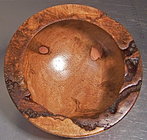
This Maple log had two different types of worms, making small and larger holes on opposite sides of the log.
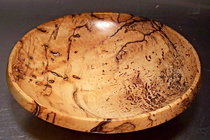
This is one where I was almost too late with turning the wood, also difficult to get a good surface and finish.
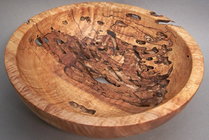
Hop-horn-beam aka Ironwood with worm holes and left like that.
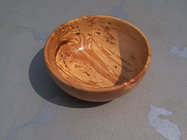
Here is one that I filled with copper, these were carpenter entrance holes and tunnels in a curly Red Oak log, filled with powdered copper in the holes and also some in the open grain.

This Maple log had two different types of worms, making small and larger holes on opposite sides of the log.

This is one where I was almost too late with turning the wood, also difficult to get a good surface and finish.

Hop-horn-beam aka Ironwood with worm holes and left like that.

I have never tried to color it and I don't know of any brand that comes in colors. When I use it to fill large voids after it is set I up I sand or cut it flush with the surrounding wood then I under cut with a Dremel tool about 1/16" deep and fill with powered mineral usually turquoise and thin CA. The 4 mesquite burl bowls were all done that way including the second from the left where the weird edge that was caused by how the blank was cut and there was no wood on that corner.Don, I've only tried Milliput epoxy putty a few times. Worked OK but very limited colors and hard to mix other coloring with it well. Are there others you've used? Like you said, the attraction is that it stays in place while working with it. You can also work and smooth with damp tools and sands well.
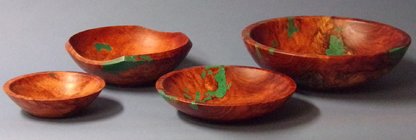
I just hate getting surprised by grubs. It's gross to clean the guts off my arms and face shield.
I do know that they do not taste good, DAMHIKTI just hate getting surprised by grubs. It's gross to clean the guts off my arms and face shield.
